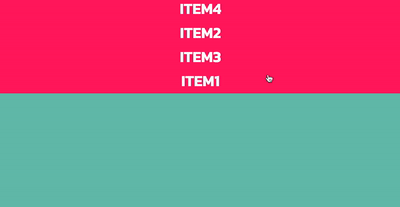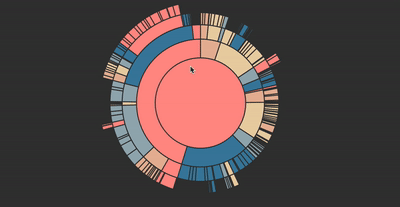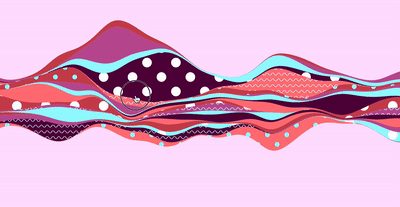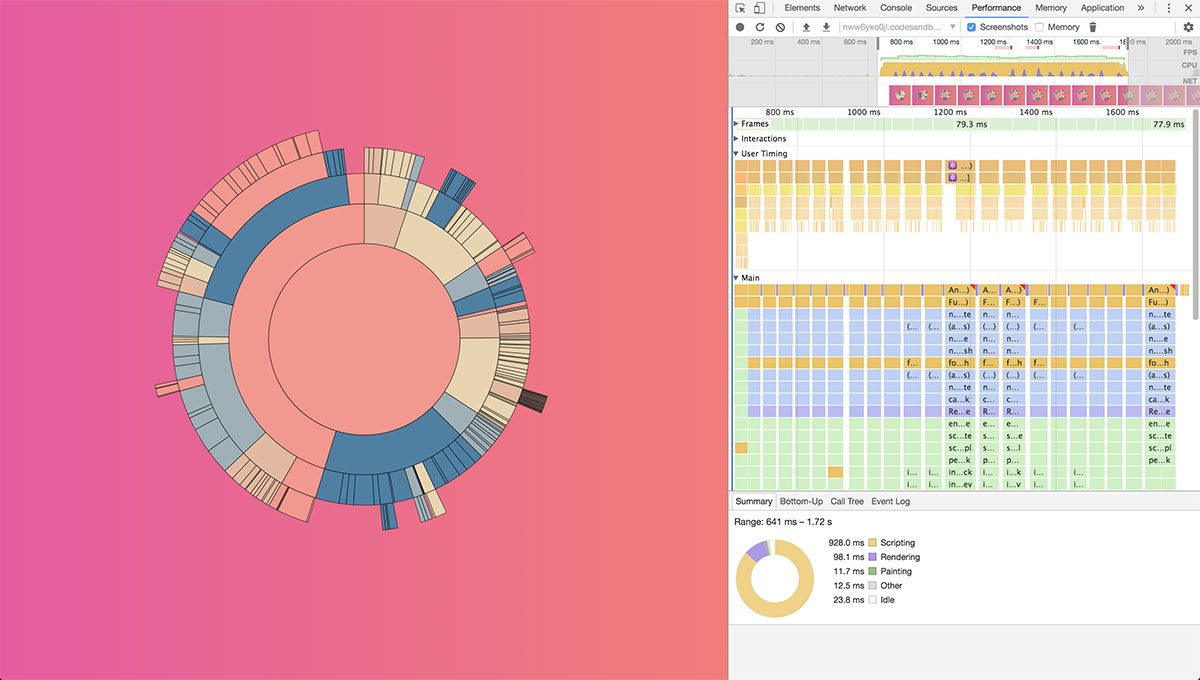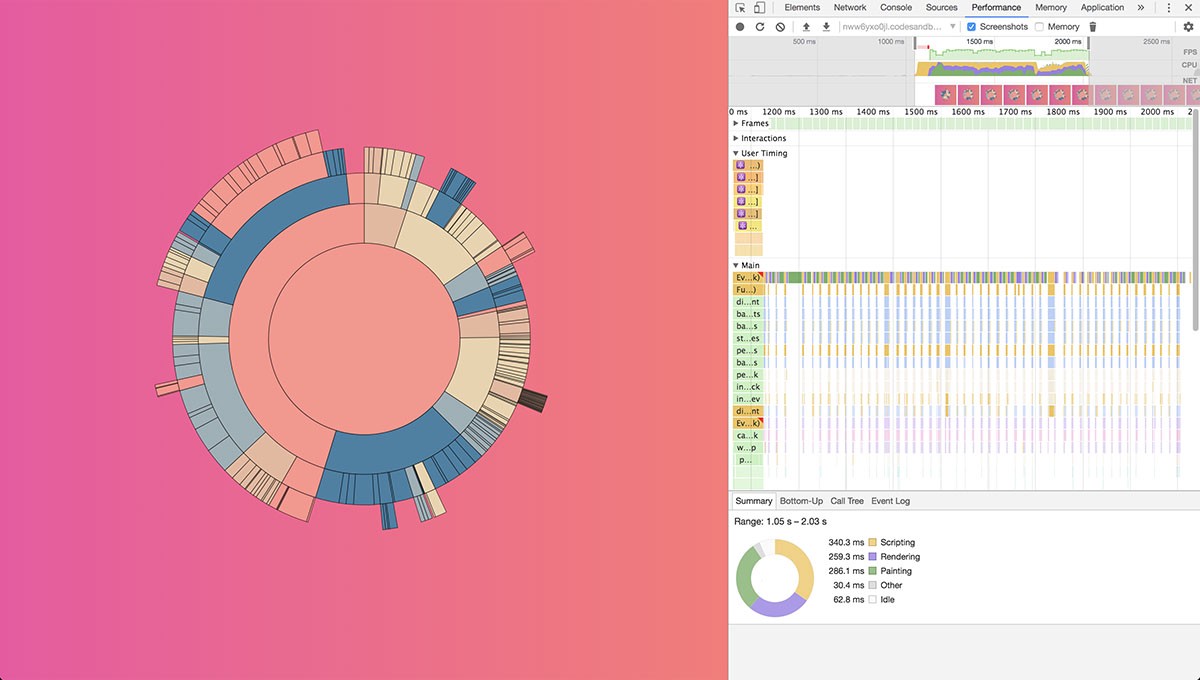npm install react-spring
A set of simple, spring-physics based primitives (as in building blocks) that should cover most of your UI related animation needs once plain CSS can't cope any longer. Forget easings, durations, timeouts and so on as you fluidly move data from one state to another. This isn't meant to solve each and every problem but rather to give you tools flexible enough to confidently cast ideas into moving interfaces.
react-spring is a cooked down fork of Christopher Chedeau's animated (which is used in react-native by default). It is trying to bridge it with Cheng Lou's react-motion. Although both are similarily spring-physics based they are still polar opposites.
| Declarative | Primitives | Interpolations | Performance | |
|---|---|---|---|---|
| React-motion | ✅ | ✅ | ❌ | ❌ |
| Animated | ❌ | ❌ | ✅ | ✅ |
| React-spring | ✅ | ✅ | ✅ | ✅ |
react-spring builds upon animated's foundation, casting its imperative side out, making it leaner and more flexible. It inherits react-motions declarative api and goes to great lengths to simplify it. It has lots of useful primitives, can interpolate mostly everything and last but not least, can animate by committing directly to the dom instead of re-rendering a component frame-by-frame.
For a more detailed explanation read Why React needed yet another animation library.
Springs (Demo)
A Spring will move data from one state to another. It remembers the current state, value changes are always fluid.
import { Spring } from 'react-spring'
<Spring from={{ opacity: 0 }} to={{ opacity: 1 }}>
{styles => <div style={styles}>i will fade in</div>}
</Spring>Mount/unmount Transitions (Demo)
Transition watches elements as they mount and unmount, it helps you to animate these changes.
import { Transition } from 'react-spring'
<Transition
keys={items.map(item => item.key)}
from={{ opacity: 0, height: 0 }}
enter={{ opacity: 1, height: 20 }}
leave={{ opacity: 0, height: 0 }}>
{items.map(item => styles => <li style={styles}>{item.text}</li>)}
</Transition>2-state Reveals (Demo)
Given a single child instead of a list you can reveal components with it.
import { Transition } from 'react-spring'
<Transition from={{ opacity: 0 }} enter={{ opacity: 1 }} leave={{ opacity: 0 }}>
{toggle ? ComponentA : ComponentB}
</Transition>Trails and staggered animations (Demo)
Trail animates the first child of a list of elements, the rest follow the spring of their previous sibling.
import { Trail } from 'react-spring'
<Trail from={{ opacity: 0 }} to={{ opacity: 1 }} keys={items.map(item => item.key)}>
{items.map(item => styles => <div style={styles}>{item.text}</div>)}
</Trail>Parallax and page transitions (Demo)
Parallax allows you to declaratively create page/scroll-based animations.
import { Parallax } from 'react-spring'
<Parallax pages={2}>
<Parallax.Layer offset={0} speed={0.2}>
first Page
</Parallax.Layer>
<Parallax.Layer offset={1} speed={0.5}>
second Page
</Parallax.Layer>
</Parallax>Time/duration-based implementations and addons (Demo)
You'll find varying implementations under /dist/addons. For now there's a time-based animation as well common easings, and IOS'es harmonic oscillator spring. All primitives understand the impl property which you can use to switch implementations.
import { TimingAnimation, Easing } from 'react-spring/dist/addons'
<Spring impl={TimingAnimation} config={{ delay: 200, duration: 1000, Easing.linear }} ...>Keyframes (Demo)
Keyframes orchestrates animations in a script that you provide. Theoretically you can even switch between primitives, for instance going from a Spring, to a Trail, to a Transition. It tries its best to remember the last state so that animations are additive. Animation can be awaited and return current props. Be warned: the keyframe API is still highly experiemental and can be subject to changes.
import { Keyframes, Spring } from 'react-spring'
<Keyframes script={async next => {
await next(Spring, { from: { opacity: 0 }, to: { opacity: 1 } })
await next(Spring, { to: { opacity: 0 } })
}}>
{styles => <div style={styles}>Hello</div>}
</Keyframes>- Springs and interpolation: https://codesandbox.io/embed/oln44nx8xq
- Native springs: https://codesandbox.io/embed/882njxpz29
- Mount/Unmount transitions: https://codesandbox.io/embed/j150ykxrv
- Reveals: https://codesandbox.io/embed/yj52v5689
- Trails/Staggered motion: https://codesandbox.io/embed/vvmv6x01l5
- Horizontal paged parallax: https://codesandbox.io/embed/548lqnmk6l
- Vertical scrolled parallax: https://codesandbox.io/embed/0oonqxnpjl
- Time/duration https://codesandbox.io/embed/q9lozyymr9
- Keyframes/single script: https://codesandbox.io/embed/j1w4355593
- Keyframes/multiple scripts: https://codesandbox.io/embed/zl35mrkqmm
- SVG morphing/custom interpolaters: https://codesandbox.io/embed/lwpkp46om
- D3 stream graps: https://codesandbox.io/embed/py3p5p11m7
- D3 area graphs: https://codesandbox.io/embed/j3x61vjz5v
- D3 sunbursts: https://codesandbox.io/embed/nww6yxo0jl
- D3 trees: https://codesandbox.io/embed/9jrjqvq954
- Routing: https://codesandbox.io/embed/mjnwrk1o3p
- Horizontal gestures / occlude: https://codesandbox.io/embed/jzn14k0ppy
- Vertical gestures / drag-n-drop: https://codesandbox.io/embed/l9zqz0m18z
- Animated TodoMVC: https://codesandbox.io/embed/2pk8l7n7kn
For a raw documentation of all possible properties look here.
You can interpolate almost everything, from numbers, colors, svg-paths, percentages, arrays to string patterns:
<Spring to={{
scale: toggle ? 1 : 2,
start: toggle ? '#abc' : 'rgb(10,20,30)',
end: toggle ? 'seagreen' : 'rgba(0,0,0,0.5)',
stop: toggle ? '0%' : '50%',
rotate: toggle ? '0deg' : '45deg',
path: toggle ? 'M20,380 L380,380 L380,380 Z' : 'M20,20 L20,380 L380,380 Z',
vector: toggle ? [1,2,50,100] : [20,30,1,-100],
}}>A couple of extra props you might be interested in are onRest, which fires once the animations stops, onFrame, which fires on every frame and gives you the animation value, reset, which literally resets the spring so that it goes through from to to again, immediate which can enforce values to spring to their to-values immediately (can be true for a zero-time spring or an array where you can pass the key-names individually).
Don't like the way render props wrap your code?
const Header = ({ children, bold, ...styles }) => (
<h1 style={styles}>
{bold ? <b>{children}</b> : children}
</h1>
)
<Spring render={Header} to={{ color: 'fuchsia' }} bold>
hello there
</Spring>Et voilà! Header animates on prop changes! Props that Spring doesn't recognize will be spread over the receiving component, in this example bold, but it also includes children if you use render to refer to the render-child.
Native rendering and interpolation (Demo)
By default we'll render every frame (like in the image on the left) as it gives you more freedom (for instance this is the only way that you can animate React-component props). In situations where that becomes expensive use the native flag. The flag is available for all primitives (Spring, Transition & Trail, Keyframes, Parallax is native by design). Try doing this in all situations where you can, the benefits are worth it. Especially if your animated component consists of large subtrees, routes, etc.
Just be aware of the following conditions:
nativeonly animates styles and attributes- The values you receive are opaque objects, not regular values
- Receiving elements must be
animated.[elementName], for instancedivbecomesanimated.div - If you need to interpolate styles use
interpolate
import { Spring, animated, interpolate } from 'react-spring'
<Spring native from={{ radius: 0, time: 0, x: 0, y: 0 }} to={{ radius: 10, time: 1, x: 10, y: 20 }}>
{({ radius, time, x, y }) => (
<animated.div
style={{
// Use plain animated values like always, ...
borderRadius: radius,
// For interpolations, call "interpolate" on the value itself, it accepts a function
background: time.interpolate(t => 'rgba(0, 0, 0, ${t})'),
// ... or supply a range clamp
color: time.interpolate({ range: [0, 1], output: ['red', 'rgba(1, 50, 210, 0.5)'] }),
// Or use generic interpolate, which takes multiple values, it accepts a function
transform: interpolate([x, y], (x, y) => `translate(${x}px, ${y}px)`),
}}>
</animated.div>
)}
</Spring>Animates children as they mount and unmount. from denotes base styles, enter styles are applied when objects appear, leave styles are applied when objects disappear. Keys and children have to match in their order! The keys are the same that you would provide in any other looping situation.
import { Transition } from 'react-spring'
<ul>
<Transition
keys={items.map(item => item.key)}
from={{ opacity: 0, height: 0 }}
enter={{ opacity: 1, height: 20 }}
leave={{ opacity: 0, height: 0 }}>
{items.map(item => styles => <li style={styles}>{item.text}</li>)}
</Transition>
</ul>You can use this prototype for two-state reveals, simply render a single child that you can switch out for another. You don't have to pass keys for this one.
<Transition from={{ opacity: 0 }} enter={{ opacity: 1 }} leave={{ opacity: 0 }}>
{toggle ? ComponentA : ComponentB}
</Transition>For more complex animations you can return per-object styles individually. Let Transition know the actual data by passing it raw to items, either pass your keys like always or give it an accessor. And for more control, there's update which fires for nodes that are neither entering nor leaving.
<Transition
items={items}
keys={item => item.key}
from={item => ({ opacity: 0 })}
enter={item => ({ opacity: 1 })}
update={item => ({ opacity: 0.5 })}
leave={item => ({ opacity: 0 })}>
{items.map(item => styles => <li style={styles}>{item.text}</li>)}
</Transition>Trail animates the first child of the list you pass, the others will follow in a trailing motion. The api is similar to Transition though it will assume your list is fixed.
import { Trail } from 'react-spring'
<Trail from={{ opacity: 0 }} to={{ opacity: 1 }} keys={items.map(item => item.key)}>
{items.map(item => styles => <div style={styles}>{item.text}</div>)}
</Trail>Parallax creates a scroll container. Throw in any amount of layers and it will take care of moving them in accordance to their offsets and speeds.
Parallax.pages determines the total space of the inner content where each page takes 100% of the visible container. Layer.offset determines where the layer will be at when scrolled to (0=start, 1=1st page, ...). Layer.speed shifts the layer in accordance to its offset, values can be positive or negative.
import { Parallax } from 'react-spring'
<Parallax pages={3} scrolling={false} horizontal ref={ref => this.parallax = ref}>
<Parallax.Layer offset={0} speed={0.5}>
<span onClick={() => this.parallax.scrollTo(1)}>
Layers can contain anything
</span>
</Parallax.Layer>
</Parallax>
